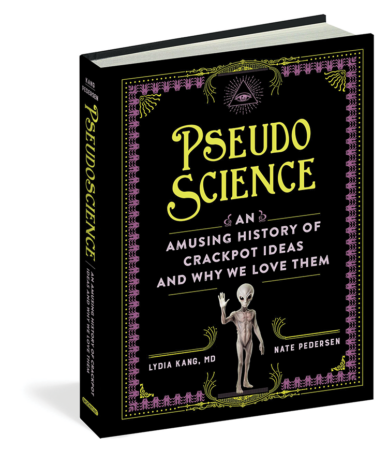Have you heard about….?
Of course you have. It’s been all over social media for months and if you didn’t see it there, someone in your family said something about it or a friend did and you still think it’s untrue. It’s hard to fight nonsense, you know — although admittedly, it’s fun to read those fake “science” reports. So get the new book “Pseudoscience” by Lydia Kang, MD and Nate Pedersen, go ahead, and indulge.
“It’s OK to reserve judgment until the evidence is in.”
When he was asked for his “gut feeling” on subjects that are unknown, the great Carl Sagan usually answered with some version of those words. And, say Kang and Pedersen, “he’s right.” Waiting for correct, valid confirmation of facts is much better than overreacting and sharing wrong information. Waiting, say the authors, is the best thing to do, even though “staking a claim” on information can make you “feel pretty good.”
Take, for instance, the idea that the Earth is flat. If you disagree with that, well, you’re not alone: most flat-Earthers disagree with one another on various details. Either way you go, the authors invite you to built a rocket ship and check for yourself.
Hey, it’s happened.
Spontaneous Human Combustion has a perfectly valid explanation. There’s some medical truth in certain kinds of body divination, but most of it’s hooey. Bumps on someone’s skull are good indications of (are you ready for this?)… bumps on their skull. Seeing ghosts may have basis in medicine. Your birth month really has little to do with your personality. Cryptids “have been reportedly seen but never with definitive proof.” The jury’s still out on cryogenics but future successes are absolutely not guaranteed. Chickens can’t tell the future, and neither can their entrails. And you can pretend to levitate but actually doing it? Nope.
So, here’s the thing about “Pseudoscience”: it’s not going to change any minds. No matter how many times you show someone what’s inside this book, it very likely won’t make one bit of difference in anyone’s logic, either way.
The appeal, instead, probably lies with someone who believes the truth and enjoys thinking about these “crackpot ideas” anyhow because, paraphrasing Sagan, judgment can be withheld and it’s OK. It’s even fun to read about that which authors Kang and Pedersen put to rest, once and for (maybe) all, and to think about the “but”s.
The other good news is that there are a lot of paranormal, weird, odd, unexplained events that have happened around the world and throughout time that are not in “Pseudoscience.” That just means that there’s plenty of room for enjoying other wild stories and ideas, still plenty of what-iffing, and giving your imagination a workout.
Keep in mind that “Pseudoscience” is not just for skeptics; it’s full of answering chapters for doubters, but also for anyone who collects and loves conspiracy theories, and for your favorite smarty-pants. If you’re curious with a streak of open-mindedness, open the covers and pick one to read about.
“Pseudoscience: An Amusing History of Crackpot Ideas and Why We Love Them” by LydiaKang, MD and Nate Pedersen
c.2025, Workman
$25.00
310 pages




_12_10_25.jpg)